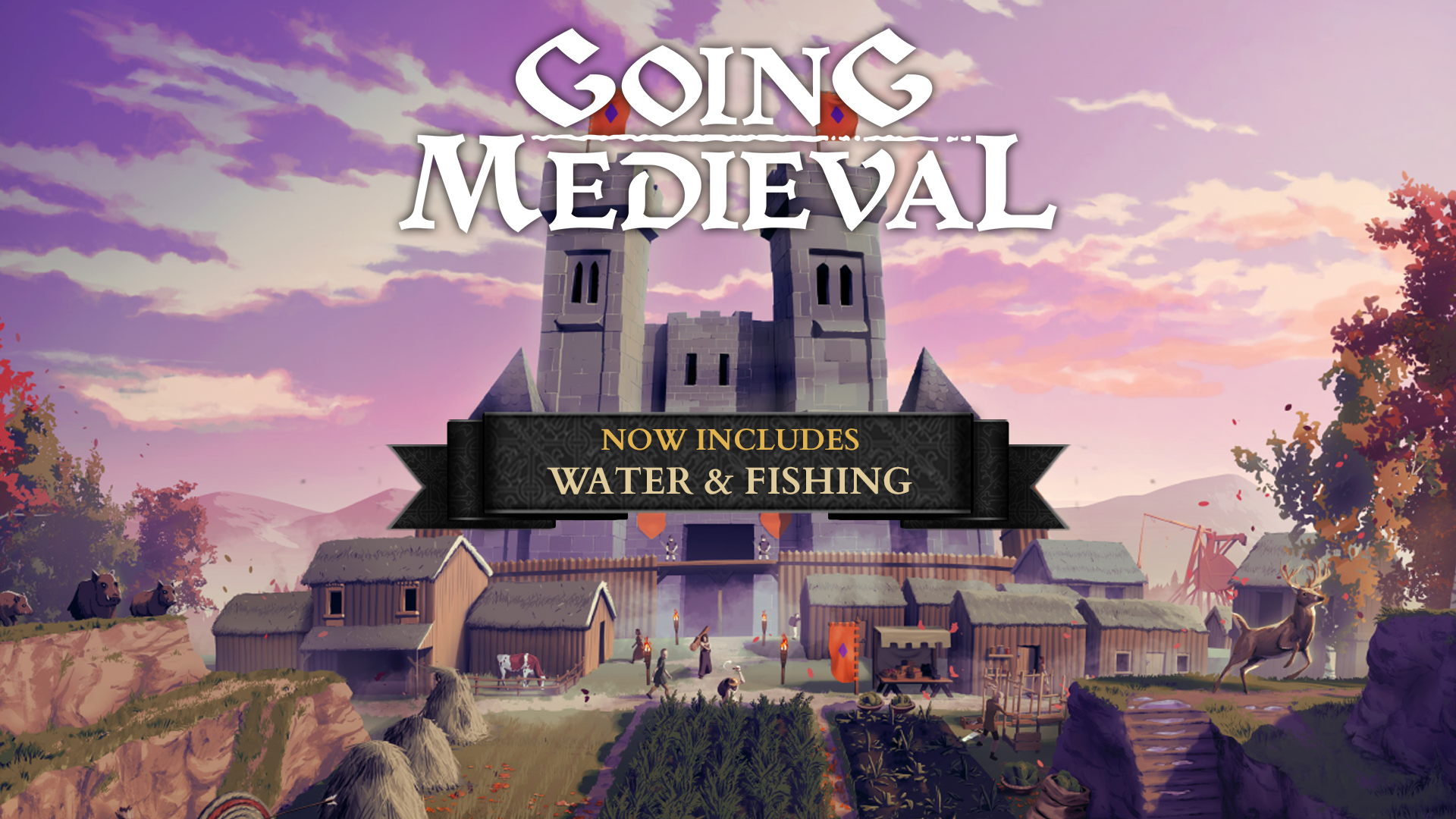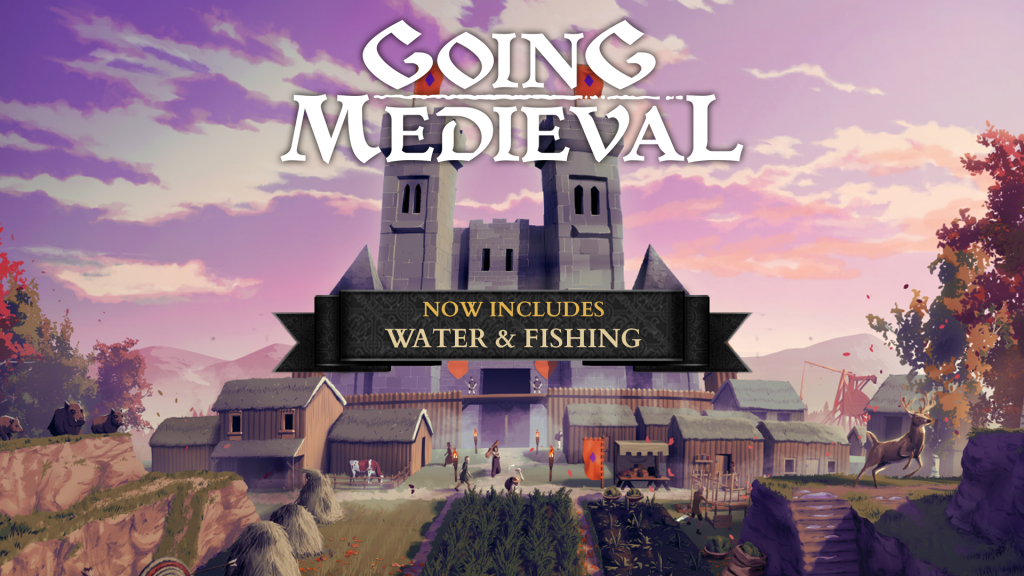Greetings, medievalists!
The new major update, titled “Water & Fishing” is now live on Steam, Epic Games Store, and GOG! It includes: Water system & bodies of water, a new map type, new flora & fauna, and much more!
Watch the video below to see the update’s highlights and, if you want to go into more detail, check beneath the video for the full update notes:
We’ll separate log into different segments:
Water – [Community request]
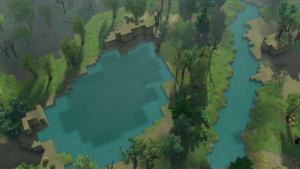
Water is finally in the game! It will appear on almost every map type as bodies of water like lakes and rivers, as long as a new game is started. There’s a chance for a map to not have a river or a lake on it, but that’s because the seed is randomly generated and calculated.
It has an aesthetic value. Water’s temperature changes throughout the year, from season to season. It will be coldest during winter and spring.
Water will move when given the chance, so digging a hole next to a lake or river will make the water go to that empty spot. The way water is simulated is not supposed to be very realistic, but is instead simplified and follows some basic logic.
Levels of water
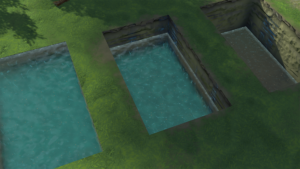
Water is consistent, meaning that a full voxel of water will spread out on more voxels while lowering its core level. For the gameplay purposes of Going Medieval, water will have 3 levels: Shallow, Low and Deep. This will also make it clear if water can be traversed by foot or if it is deep enough to swim in. Here are key notes for each level:
Shallow water
- About 30cm real world depth (1/10 of the whole voxel).
- Settlers, raiders and animals can walk/run through it (yes, even rats and small animals. We are ok with this. :D).
- Settlers can construct stuff, pickup piles, eat & drink, they can also harvest/slaughter/train animals.
- Production buildings and beds don’t work in this depth.
- Leisure activities (praying and backgammon) and furniture are allowed in this depth.
- Willow trees, reeds, bushes, tall grass, birch trees and herbs don’t loose hp in shallow water.
- Crop Fields can’t be placed on this depth except willow trees.
Low water
- About 170cm realworld depth (around 3/5 of the whole voxel).
- Settlers (regardless of their height), raiders and animals swim in this depth.
- Leisure activities (praying and backgammon) and furniture are not allowed in this depth.
- Settlers can still construct stuff, pickup piles, eat & drink (they will not use chairs in low water).
- Settlers, raiders and animals can’t climb out of low water without ladders or stairs/slopes.
- If there is a floor that above low water, settlers, raiders and animals will swim under it,
- Settlers can’t harvest/slaughter/train animals while the animal is in low water (or deeper).
- Enemies can’t attack prod buildings that are in low water.
- Traps will not work on this depth.
- Torches and braziers will not work on this depth, but wall torches will.
Deep water
- 3m of water (one whole voxel).
- Settlers (regardless of their height), raiders and animals swim in this depth.
- Settlers can still construct stuff, pickup piles, eat & drink.
- Settlers, raiders and animals can climb out of deep water without ladders or stairs/slopes.
- Animals can’t eat bushes that are in deep water, can’t eat piles or carcasses that are in deep water.
- Enemies can’t attack prod buildings that are in deep water.
Different water levels can be layered on top of each other, so you might have deep water (3m) and shallow water over it. In that case, settlers will behave as if in deep water.
Water movement
Water will flow if there is available space for it. It can be blocked by the ground, but also some buildings.
- Water will flow through open doors, grated doors, wicker doors and barn doors.
- Water can go through grated and wicker floors.
Fishing
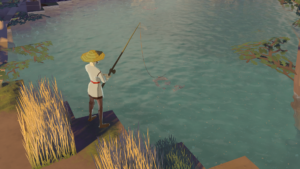
Fish can spawn in rivers and lakes and can be marked by the player to be fished and used as a resource. Fish spawn logic is similar to plants in a way that they spawn on a location (in this case water) and the settler comes and harvests them. Here is what you need to know about this process:
- Animal handling skill will influence fishing performance.
- Fishing is a part of the Animal Husbandry job and is performed via order located in the bottom right side of the screen or right clicking on fish after you’ve selected a settler.
- Fish spawns in all bodies of water, but should spawn near a coast during the map generation.
- Hovering on the fish group will display the fish type in the lower left corner of the screen.
- If the fishing goal fails the first time, settlers will try to fish again.
- Fish have more “fishing jobs” in them, meaning it will take several successful catches to deplete one fishing spot. Each fishing involves more fish resources.
- Fishing piles that are spawned as a result of fishing are reserved by a fisherman.
- After completing fishing, settlers will haul their catch to a stockpile (haul needs to be allowed for this to work).
- Fish will die if the water is drained and will drop a small amount of resources in its place.
- Fish pile is forbidden by default if fish dies, but allowed when a worker catches it.
- You can fish for pike, trout and eel.
- Pike is just one fish and offers a larger chance of failure during the fishing process, but provides more meat if caught.
- Trout flock offers multiple fishes to catch and a smaller chance to fail, but there is not that much meat in the flock.
- Eel are somewhere in-between pike and trout when it comes to chance failure and resource gain.
- Map types can have a different combo of fishes. For instance, marsh maps have more eels and other maps have a combination of trouts and pikes.
- Location in relation to the shore is also influencing what type of fish it spawns.
- Once fished, you can smoke and salt them and turn them into corresponding meals.
Marsh map
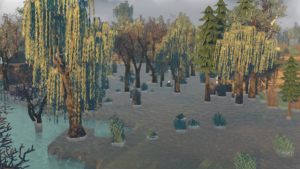
What makes a marsh different from other map types (valley, hillside and mountain) is that their terrain will be covered with 50% of shallow water. Here are other notable things you can expect on the Marsh map:
- Marsh soil – similar to the regular soil, but leaves shallow water where it is dug out. It appears only on marsh maps and gives only 1x soil instead of 3x like regular dirt voxels.
- Willow trees – similar to regular trees, but mostly present on marshes,
- Reeds – located mostly on marshes. They offer hay, albeit less when compared to tall dry grass.
- Water Vole – similar to a rat. Gives good leather and mostly spawns in marsh map types. Can be held in pens.
- Mallard – medium-sized waterfowl species that spawns on marsh maps. Can be held in pens.
- Metal and limestone are not present on this map type so you’ll have to acquire them via trading.
More water related info:
- Due to integration of water bodies, the look of old map seed will change if you try to start them on a new game.
- Humans and animals can fight on all water levels.
- It is possible for humans to use water for purposes of swimming upwards if there are multi storey buildings filled with water.
- Piles rot and decompose much much faster if in water (except fish piles, their decay is slowed down in that case).
- Flora doesn’t spawn in water (except willow trees and reeds).
- Reed will start dying if it’s deprived of water.
- If you start a trade with another village located in the marsh map type, expect that the stock of that village will probably lack limestone but will offer more herbs.
- Piles stored on shelves will not be affected by the shallow water.
- Water is not drinkable.
- Rain will not fill the empty pit with water.
- Irrigation is not a thing as of now.
Some of these things might be revisited later in the development process, while others (like introduction of drawbridges) will be incorporated in the upcoming months.
Other Notable Stuff
Urgent Haul order
Urgent Haul is a new order type located in the Jobs panel that is separated from the regular haul. This will give you more control when it comes to prioritization and which settler will respond to the Urgent Haul order. Here is how it works:
- There is a new “Urgent Haul” button located in the lower right corner of the screen.
- Settlers that have only urgent haul on (regular haul off) will only haul urgent marked piles and not the ones that are not marked.
- Settlers that have haul on (urgent haul off) will haul urgent marked piles too, but they will not prioritize them during the hauling process.
- Pets will follow urgent haul orders, too, regardless of their owner’s priorities.
- A pile can’t be forbidden and urgent haul marked at the same time.
- A pile that’s on a stockpile can’t be marked as an urgent haul except if the pile can be moved to a better stockpile.
- Shelved piles cant be marked for urgent haul.
Quality of life changes
- Pets and domestic animals can be tended to now, but only with right-click prioritize tending. Does not work automatically like with settlers.
- Limestone (impure) is a new type of the voxel we’ve added. It looks exactly like the regular limestone but gives less resources, has less HP and is faster to dig. It will only be found on mountain maps. This is so players can dig those maps faster and not have a gazillion limestone around. Don’t worry, ordinary limestone is still present on mountain maps and is the same as before.
- Using the Overview tab now pauses the game.
- Rain will not appear as frequently in Spring and Autumn.
- Some dropdown issues were solved (dropdowns in the Manage panel were scrolled too slow with the mouse wheel).
- Forbidding blueprints is in the game. Players can pause a construction by forbidding it.
- Treated wounds time has been readjusted so it lasts 24h. Before it was 920 in-game minutes.
- We’ve introduced temporary building ownership. Before, if the settler’s room or bed is too far and there is a bed closer to the settler, the settler would choose the closer bed. This resulted in settlers randomly losing ownership of beds. Now the settler will still choose a bed closer to them but the new bed will have a message that it is temporarily occupied. This can only happen if there are more beds than settlers on the map and a settler can only temporarily occupy a bed that was not assigned before. This fixes the issue where settlers would sometimes lose ownership of beds/rooms.
- Production circle would remain blue even when it has all of the necessary resources in it. It will turn yellow only when settlers start using a production building.
That would be all for the official update notes. New patches and improvements will be deployed accordingly. In the meantime, feel free to post your experience regarding the new update on Steam discussions. If you want more dynamic/direct communication – head over to our Discord server. Even though we might not reply, we are reading everything. And be sure to…
Stay medieval!
